Picher, Oklahoma
Friday, 10th July 2009 by Alex Steinberger
Picher, Oklahoma is a small town in north-eastern Oklahoma near the Kansas-Missouri border. It was once a major hub for heavy metals extraction, boasting some of the most productive lead mines in the world. By the early 1970s however, all mining operations ceased leaving 480 kilometres of underground tunnels, more than 180 million tonnes of toxic waste, and a town without much of a future.
Located in close proximity to the Tar Creek Superfund Site, the citizens of Picher have been left to deal with toxic mine tailings left over from underground drilling operations. These tailing piles, known locally as "Chat", litter the landscape, some towering one hundred metres or more above the town.
Aside from detracting from Picher's overall scenic beauty, these chat piles contain extremely fine lead dust and pose a tremendous health risk to its citizens. Children are especially susceptible to the toxic dust because elevated levels of lead in their blood can lead to learning disabilities. Lead and zinc have even contaminated Picher's drinking water as well as many swimming holes frequented by local youngsters.
To make matters worse, the kilometres of abandoned mining tunnels below the town have been collapsing since the 1950s and continue to do so even today. Due to this geological instability, much of the town has been deemed unsafe for habitation leaving many former commercial and residential blocks in disrepair.
In 1983, Picher and its surrounding mines were declared one of the most polluted places in the United States and became a top clean-up priority of the Environmental Protection Agency (EPA). In the decades since, the EPA and the U.S. Government have made repeated attempts to relocate the residents of Picher. Though a small group of stalwart individuals have resisted relocation, the town is set to close on or around September 1 of this year. On June 13, a final farewell was held, allowing long-time residents to reflect on better times.
For more information about Picher's history and final days take a look at this CNN article. Also worth checking out, "The Creek Runs Red" is a compelling documentary about the Tar Creek Superfund Site.
Thanks to Brian in Texas.
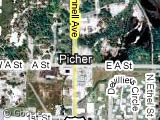
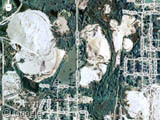
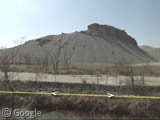
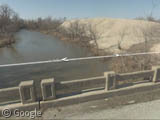
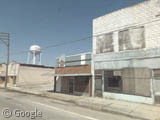
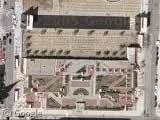

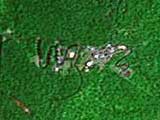
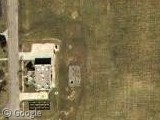
Probably a good time to pick up a bargain in the local housing market?
butte montana is also built on mines that are slowly caving in
We wrote about the infamous Berkeley Pit in Butte back in 2007:
https://www.googlesightseeing.com/2007/01/15/berkeley-pit/
Let’s see some toxic sites from Russia, Eastern Europe and China, some of the most polluted places on earth
Don’t forget about all the wonderful uses that enhances quality of life.
Lead is a major constituent of the lead-acid battery used extensively as a car battery.
Lead is used as a coloring element in ceramic glazes, notably in the colors red and yellow.
Lead is used to form glazing bars for stained glass or other multi-lit windows. The practice has become less common, not for danger but for stylistic reasons.
Lead is frequently used in polyvinyl chloride (PVC) plastic, which coats electrical cords.
Lead is used as projectiles for firearms and fishing sinkers because of its density, low cost compared to alternative products and ease of use due to relatively low melting point.[26]
Lead or “sheet-lead” is used as a sound deadening layer in such areas as wall, floor and ceiling design in sound studios where levels of airborne and mechanically produced sound are targeted for reduction or virtual elimination.
Lead is used in some candles to treat the wick to ensure a longer, more even burn. Because of the dangers, European and North American manufacturers use more expensive alternatives such as zinc.[27]
Lead is used as shielding from radiation, e.g. in x-ray rooms.
Molten lead is used as a coolant, eg. for lead cooled fast reactors.
Lead glass is composed of 12-28% lead oxide. It changes the optical characteristics of the glass and reduces the transmission of radiation.
Lead is the traditional base metal of organ pipes, mixed with varying amounts of tin to control the tone of the pipe.
Lead is used as electrodes in the process of electrolysis.
Lead is used in solder for electronics, although this usage is being phased out by some countries to reduce the amount of environmentally unfriendly waste.
Lead is used in high voltage power cables as sheathing material to prevent water diffusion into insulation.
Lead is added to brass to reduce machine tool wear.
Some artists using oil-based paints continue to use lead carbonate white, citing its properties in comparison with the alternatives.
Lead, in the form of strips or “tape” is used for the customization of tennis rackets. Tennis rackets of the past sometimes had lead added to them by the manufacturer to increase weight.
Lead has many uses in the construction industry, e.g. lead sheets are used as architectural metals in roofing material, cladding, flashings, gutters and gutter joints, and on roof parapets. Detailed lead moldings are used as decorative motifs used to fix lead sheet.
Lead is still widely used in statues and sculptures.
Tetra-ethyl lead is used as an anti-knock additive for aviation fuel in piston driven aircraft.
Lead-based semiconductors, such as lead telluride, lead selenide and lead antimonide are finding applications in photovoltaic (solar energy) cells and infrared detectors.[28]
Imagine a world where tennis rackets couldnt be customised with a lead strip! It doesnt even bear thinking about.
As if things were bad enough already for Picher, it suffered heavy damage and several deaths in a tornado last year.
Not sure if Zach’s list is serious … or if he is spoofing ‘Zinc Oxide and You’ from ‘Kentucky Fried Movie’.
The erroneously copied footnote number [28] immediately gives this away as a copy and paste from Wikipedia… The posters intent however, you’ll have to ascertain for yourself 😉
http://en.wikipedia.org/wiki/Lead
and why wasn’t any of this cleaned up after all the people we’re evicted from pincer,ok. we have so many of these places, we take and take from earth,but never clean up after ourselves.
Picher was a city in Ottawa County, Oklahoma, United States. It was formerly a center of lead and zinc mining. The population was 1,640 at the 2000 census.